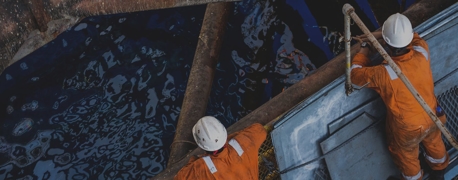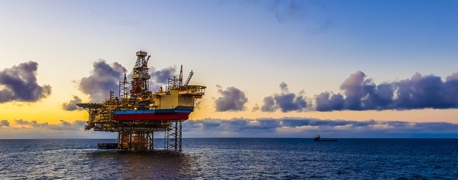Bunkering Fraud: Old but Growing Practice Threatens Shipping Workers

Bunkering is the maritime industry term for refueling shipping vessels. “Bunker” is the catch-all term for maritime fuel and lube oils delivered for ship operation. “Bunkers” also refers to the specialized maritime vessels that deliver bunker and carry out bunkering operations, but trucks sometimes also carry out bunkering operations in ports.
Ship-to-ship (STS) bunkering operations are fairly complex. Multiple safety and compliance checklists are passed between the officers of both vessels. They require coordination between two crews, both of whom are handling a potentially dangerous and toxic substance.
The standard procedure for bunkering typically follows this order:
- Chief Engineers (or designated person-in-charge, or PIC) of both vessels lead a meeting with relevant crew members to confirm bunkering procedure and methods of communication.
- The crew of the receiving vessel consolidates the current fuel into empty tanks for filling, and the crew of the refueling vessel checks the fuel's temperature.
- Fuel is slowly pumped from a hose on the bunkering vessel to the receiving vessel, allowing the receiving crew to confirm that fuel is flowing into the correct tank at the right speed.
- Once the proper connection is confirmed, the fuel pumps faster until the required tanks are full.
- The receiving crew then checks the fuel temperature on their end, confirms they’ve received the agreed-upon amount of fuel, and disconnects.
- The receiving crew must test the fuel to ensure it meets the specs before using it. This is typically done en route to avoid delays.
How Bunkering Has Transformed Over the Last Few Decades
The bunkering industry has gone through some changes in the 21st century.
For instance, conventionally, bunkering was done in ports, but crowding due to higher traffic and increasingly large vessels has made STS bunkering in open water more common.
Bunkering was once considered a “low value” service, but the rising cost of fuel and the need for procedures to comply with environmental law has allowed bunkering services to grow considerably. As you can see, it also requires a great deal more skill and labor than refueling a car.
In 2020, the maritime industry started using VLSFOs, or Very Low Sulfur Fuel Oils, as bunker fuel. VLSFO was developed to comply with new maritime fuel standards. However, this fuel has been nicknamed "Frankenstein fuel" for its diverse composition and its largely untested effect on the environment. Frankenstein fuel has been tied to multiple grounding incidents in the last four years.
Another dimension of the fuel problem is distribution.
Maritime refueling services aren’t evenly distributed worldwide. The Port of Singapore has emerged as the largest and most important bunkering port in the world, with 25 million metric tons of fuel delivered in just the first half of 2023. To get an idea of how dominant the Port of Singapore is for refueling, the second-largest refueling port (Rotterdam) delivers one-fifth of the oil as the Port of Singapore.
But this has created a problem.
How & Why Does Bunkering Fraud Happen?
Fuel costs make up half of a shipping vessel’s expenses, but it’s an expense shipping companies have to pay. As a result, fuel suppliers have been able to get away with predatory practices that leave shipping companies overpaying for low-quality (or low quantities of) fuel. A 2023 private analysis from a maritime startup showed that 39% of bunker fuel had statistically significant alterations from what was written on its delivery paperwork.
These practices are collectively classified as “bunkering fraud.”
Fraudulent practices affect every part of the fuel supply chain. In total, they add $5 billion to shipping costs a year.
Bunkering fraud can take many forms, including:
- Fuel suppliers overcharging buyers for less fuel than they received
- Heating or aerating fuel to decrease density while increasing volume
- Fuel suppliers conspiring with vessel officers to defraud the fuel purchaser
- Vessels and fuel suppliers meeting outside of established bunkering spots to buy smuggled or stolen fuel at a discount
- Mixing fuel with water or other chemicals to sell low-grade fuel at full price
The widespread adoption of Frankenstein fuel has exacerbated the problem. Frankenstein fuels are difficult to detect because the standards for its chemical composition are so broad. Widespread fuel fraud is a direct result of the fact that Frankenstein fuels could contain any number of volatile and dangerous chemicals in varying amounts.
But the main issue shipping companies face is a lack of transparency in transactions. Certain practices, like putting new fuel into empty tanks and testing it before use, are a direct response to common predatory practices in the maritime industry.
In 2017, Singaporean port authorities mandated the use of mass flow meters to force suppliers to verify how much fuel they actually delivered. This law was so antithetical to prevailing industry practice that within two years, the Maritime & Port Authority of Singapore (MPA) had to revoke a fuel supplier’s license for using magnets to manipulate their mass flow readings.
How Does Bunkering Fraud Endanger Maritime Workers?
While shipping vessels have a certain tolerance for trace chemicals in their fuel, fuel that is too far off-spec in its density causes serious damage to the engine and fuel system. Over time, fuel filters can become clogged with excess material, heightening the risk of catastrophic power loss.
That isn’t theoretical, either. Fuel spec issues cause total loss of propulsion for hundreds of vessels every year. Repairs for these problems typically cost half a million per incident, plus the cost of towing.
Loss of propulsion is a serious problem—even only a couple of miles from a dock, as we saw in the Baltimore bridge collapse. The size and weight of shipping vessels are far too great to risk a loss of power in any context. Given how often shipping vessels lose power due to bunkering fraud, it seems virtually inevitable that something like the Key Bridge catastrophe would happen.
Baltimore wasn’t the first time we’ve seen a fatality occur due to loss of propulsion. In 2015, our firm represented four widows who lost their husbands when the El Faro sailed into a hurricane despite a history of engine problems. Like the Dali, it lost power. All 33 crew lost their lives.
Despite every port authority’s best efforts to crack down on bunkering fraud, it seems likely to continue. Until fuel suppliers are forced to pay a real price for the harm they pose to maritime workers, shipping crews will continue to pay the price of “dirty fuel.”


